Hiiiiii!
I know you’re here for the Q&As, but while you’re here, check out some of the other super interesting and useful things here, like this MMT cheatsheet, or this Lab Values cheatsheet, or this post with all of my class schedules! Or see all the posts that have to do with PT School or PT Knowledge.
As a reminder, here are the rules for the contest:
- For the month of May, some of the days Mon-Fri there will be a question kinda like a boards question.
- Comment your answer that same day. Each answer will count as two points (one answer per day). Each tag of a friend will count as one point! Each like of the post will count as one point.
- The correct answer will be posted here on this site.
- At the end of May, the person with the most point will win a $10 gift card to Panera!!
- If it’s a tie, the winner will be randomly chosen from the top scorers who tied.
Day 12
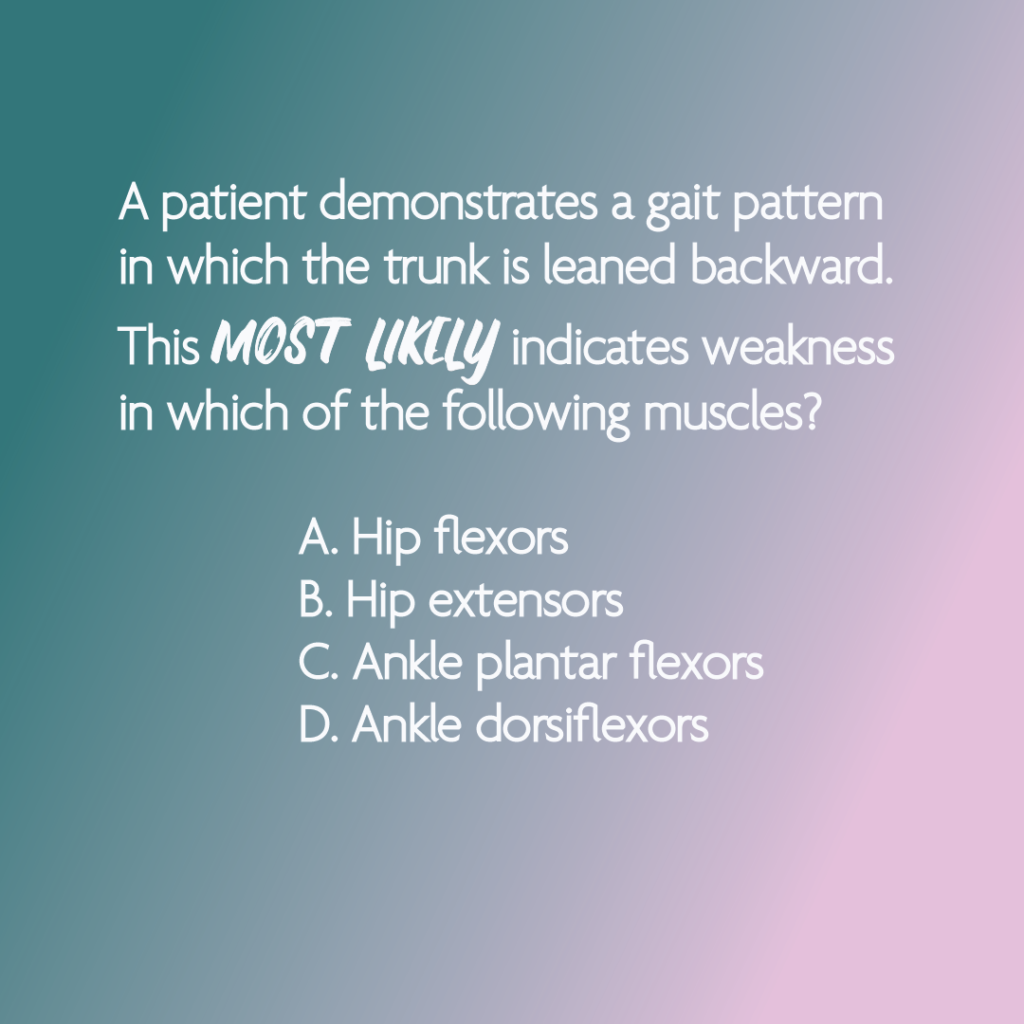
Correct answer: B
This gait deviation is due to inadequate hip extensor activity. In fact, it is sometimes called a Gluteus Maximus Limp. By leaning backwards, the GRF vector moves posteriorly, creating a smaller moment arm, and a smaller hip flexor moment. This makes it easier on the gluteus maximus muscle.
A. Weak hip flexors would result in lack of hip flexion during initial contact and circumduction during swing
C. Weak ankle plantar flexors could result in lack of toe off during pre-swing,
D. Weak ankle dorsiflexors could result in foot slap, initial contact at toe instead of heel strike, circumduction during swing, and hip hiking during swing
Day 11

Correct answer: A
This patient presentation most closely aligns with Complex Regional Pain Syndrome Type 1. Retrograde massage is indicated to help reduce pain and edema.
B. Deep friction massage is not indicated for CRPS, since it is most likely not specifically a ligament, tendon, or muscle issue that is causing the pain and swelling. While a ligament sprain may have precipitated the CRPS, this is a now a syndrome involving more than one structure.
C. While desensitization is an important strategy in the treatment of CRPS, these are usually more gentle things like touching different textures, tapping, vibration, not exercising to pain.
D. While active and passive ROM can play a role in the treatment of CRPS, vigorous stretching is contraindicated.
Day 10

Correct Answer: B
A lateral sole wedge compensates for forefoot valgus. In forefoot valgus, the forefoot is everted relative to the rearfoot and during gait the medial side of the forefoot will contact the ground prematurely.
A: Medial sole wedge would compensate for forefoot varus, which is a condition where the medial metatarsal heads tend to be higher off the ground than the lateral. This orthosis helps the medial metatarsal heads to come into contact with the ground to spread out weight bearing over all the metatarsal heads.
C: A scaphoid pad is a type of medial longitudinal arch support that offers the most minimal support. Medial arch supports are indicated for pes plans. It is placed at the medial border of the insole with the apex between the sustentaculum tali and the navicular tuberosity.
D. A metatarsal bar is a layer of firm material added across the sole, posterior to the metatarsal heads. Its purpose is to shift some of the weight from the MT heads to the MT shafts. This would be indicated for someone who is experiencing pain with due to too much pressure on their MT heads.
Day 9
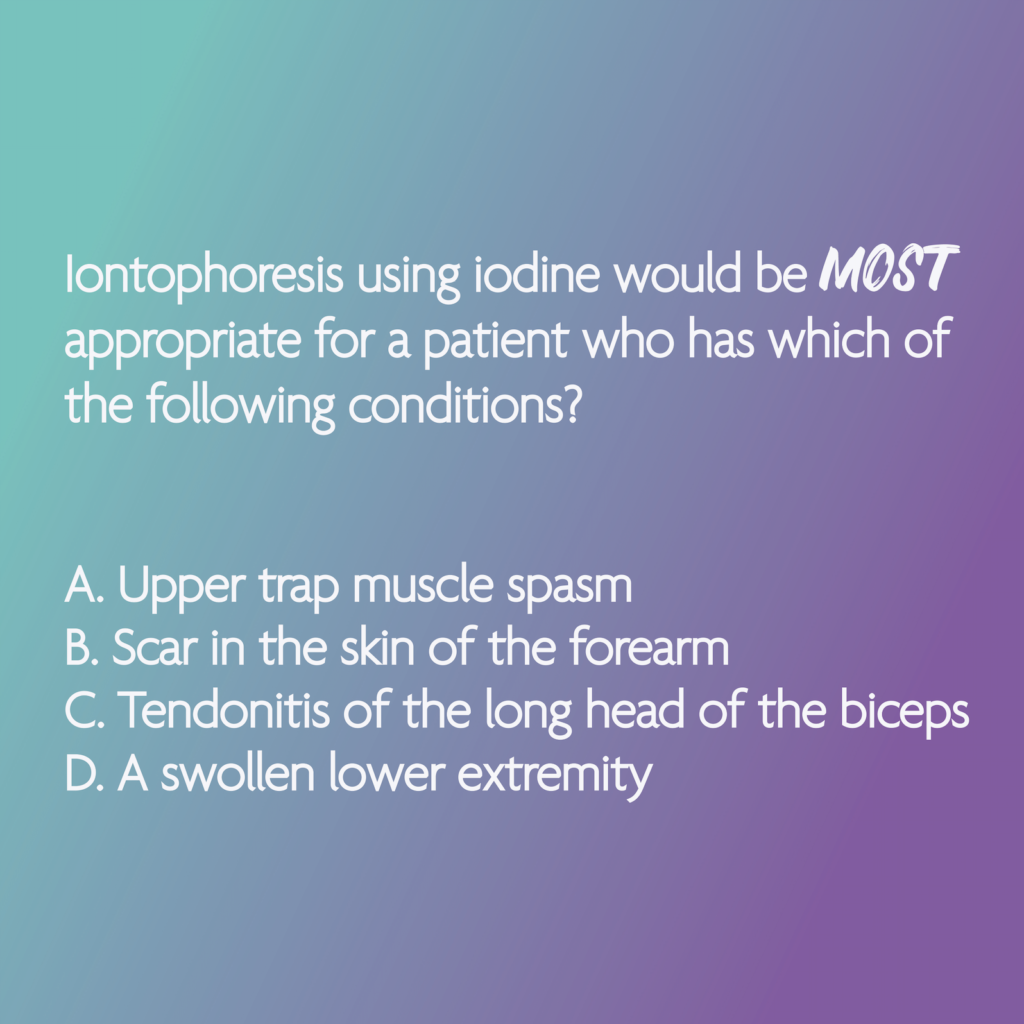
Correct Answer: B
A. Iontophoresis with magnesium is a treatment promoting muscle relaxation, using positive polarity
B. Iontophoresis with iodine is a treatment for scar, using negative polarity
C. Iontophoresis with dexamathasone is a treatment for inflammation and tendonitis, using negative polarity
D. Iontophoresis with hyaluronidase is a treatment promoting edema reduction, using positive polarity
Source: Cameron Physical Agents in Rehabilitation
Day 8
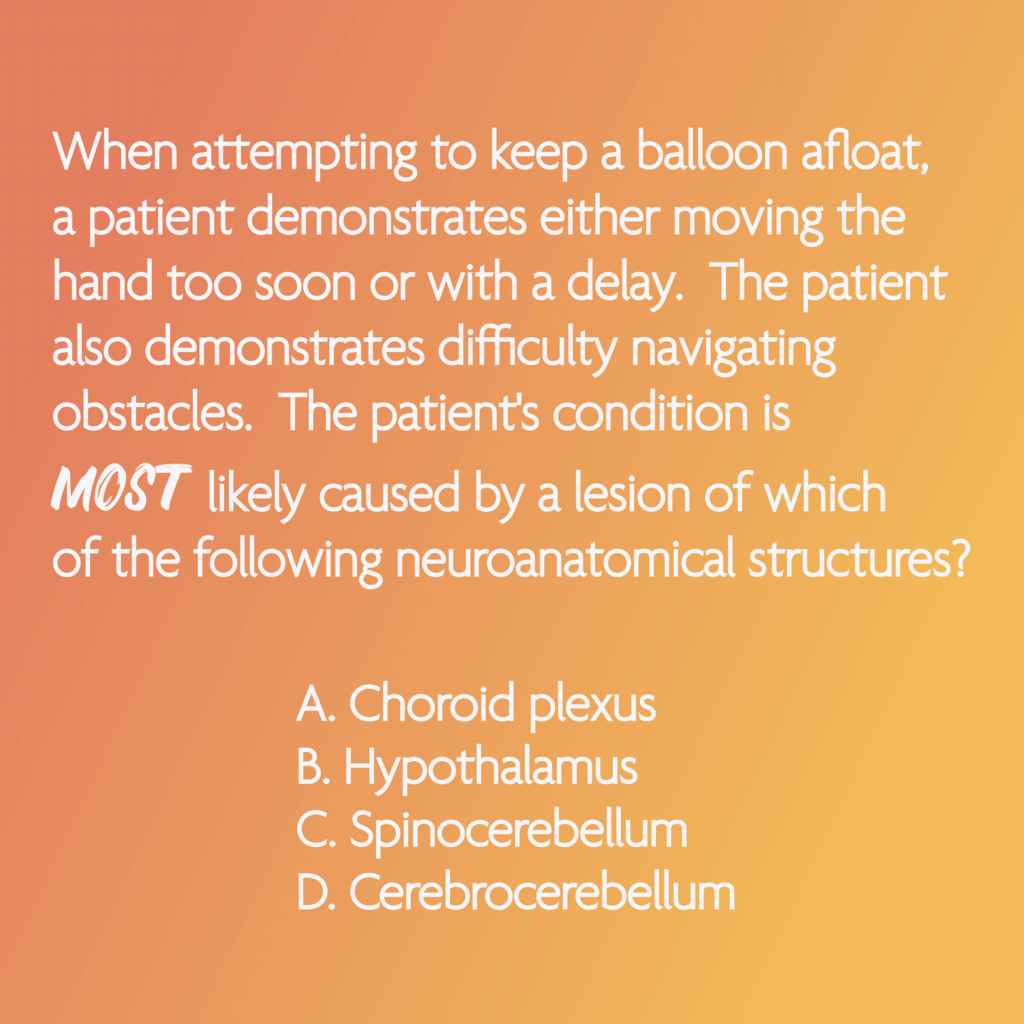
Correct Answer: D
A. The choroid plexus produces CSF.
B. The hypothalamus has a variety of functions, including connecting the nervous system with the endocrine system via the pituitary gland. It also helps regulate temperature, blood pressure, heart rate, satiety, arousal, and sleep, plus plays a role in learning and memory. We love our hypothalami!
C. Spinocerebellar lesions would cause ataxia, including dysmetria, in which a patient is unable to accurately move an intended distance.
D,. The cerebrocerebellum is involved in the planning and timing of movements, evaluating sensory information to inform action, as well as the coordination of movement.
Source: Lundy-Ekman Neuroscience
Day 7
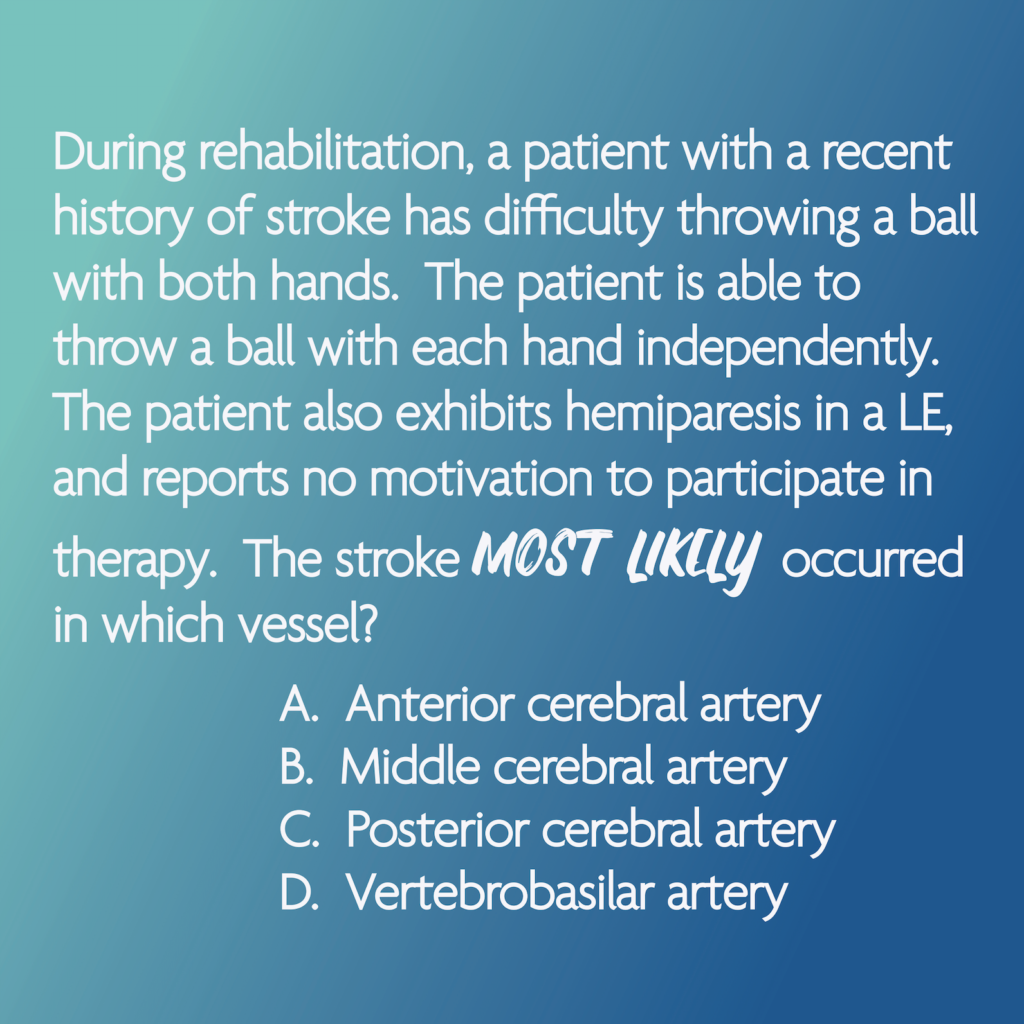
Correct Answer: A
A. A stroke in the anterior cerebral artery would produce problems with imitation and bimanual tasks/apraxia, as well as symptoms such as contralateral hemiparesis and hemisensory loss mainly in the LE, urinary incontinence, abulia, slowness/delay/lack of spontaneity/motor inaction, contralateral grasp reflex, sucking reflex
B. A stroke in the middle cerebral artery would produce contralateral hemiparesis and hemisensory loss mainly in the UE and face, Broca’s or Wernicke’s or global aphasia, perceptual deficits (neglect, depth/spatial perception, agnosia), limb-kinetic apraxia, contralateral homonymous hemianopsia, sensory ataxia, and pure motor hemiplegia
C. A stroke in the posterior cerebral artery would produce contralateral or bilateral homonymous hemianopsia, visual agnosia, prosopagnosia, dyslexia without agraphia, color discrimination problems, problems with memory, pain and dysesthesias, sensory impairments, involuntary movements, intention tremor, contralateral hemiplegia, Weber’s syndrome, oculomotor nerve palsy, paresis of vertical eye movements, slight miosis and ptosis, sluggish pupillary light response. Basically a lot of visual stuff.
D. A stroke in the vertebrobasilar artery would produce a lot of various symptoms depending on where exactly it occurred, and for this I’m going to refer you to Physical Rehabilitation, because they have a 2 page chart about it in the stroke chapter (pg 654-655)
Source: OSullivan Physical Rehabilitation
Day 6

Correct Answer: C
A. Angiomas are usually bright red, with a diameter less than 3 mm and smooth borders.
B. Melanomas usually have a diameter greater than 6 mm, with irregular borders.
C. Basal cell carcinomas usually are pearly, with rolled edges, elevated surface, and with small blood vessels on the surface (telangiectasia).
D. Actinic Keratosis is a skin disease that results from UV exposure over years, causing abnormal cell growth. The appearance is a well-defined, sandpaper-y patch, which can be light or dark, tan, pink, red, or some combo of these. Or it can be the same color as the skin. Kind of a chameleon this one.
Source: Goodman Pathology
Day 5
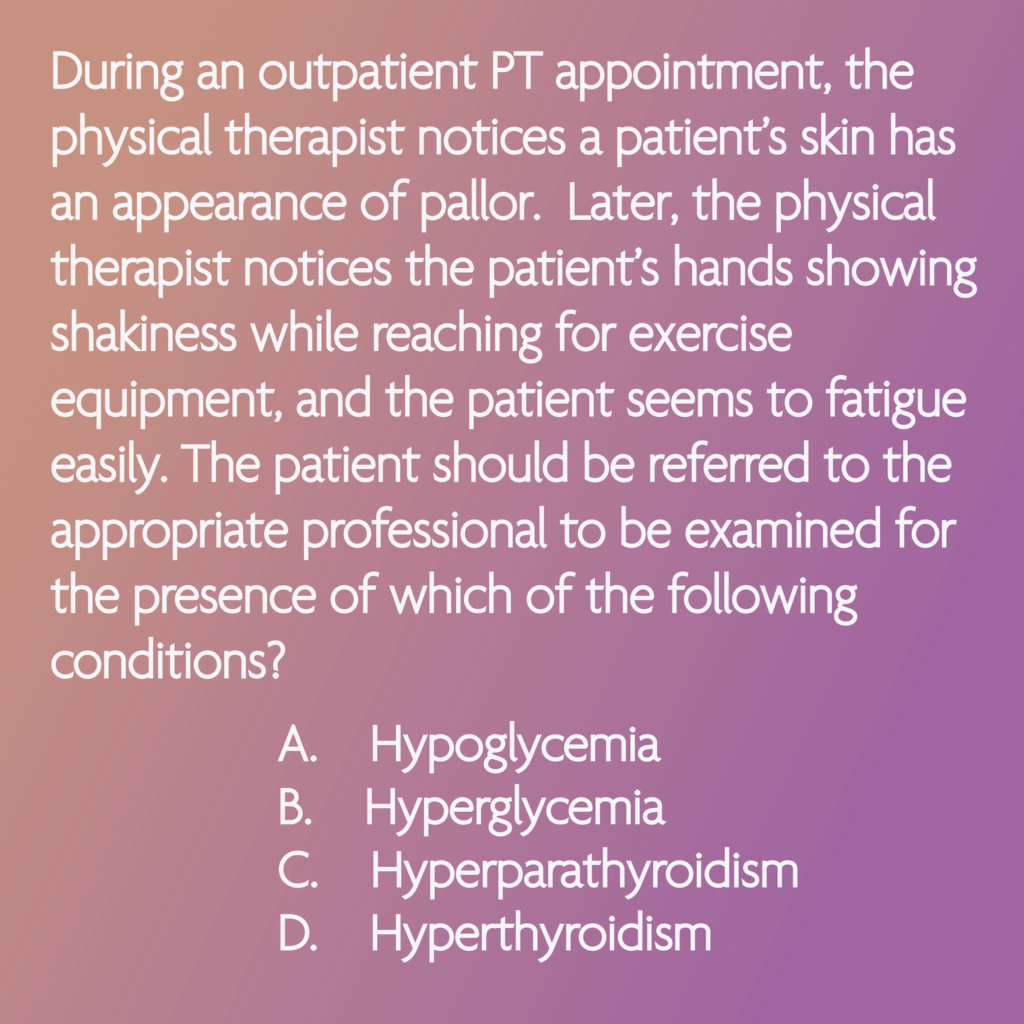
Correct Answer: A
A. A patient with hypoglycemia will most likely exhibit pallor and shakiness, as well as a fast or irregular heartbeat, anxiety, sweating, hunger, irritability.
B. Hyperglycemia is marked by lethargy, confusion, and excessive thirst.
C. Primary hyperparathyroidism is often asymptomatic, but if symptoms occur, they are usually a result of hypercalcemia. These symptoms include weakness/fatigue, bone pain, myalgias, loss of appetite, nausea/vomiting, polyuria, polydipsia, osteopenia or osteoporosis. In secondary hyperparathyroidism is usually related to excessive bone resorption, which can manifest as rickets, osteomalacia, and renal osteodystrophy.
D. Hyperthyroidism is marked by exophthalmos, weight loss, and sweating palms.
Source: Goodman Differential Dx and Goodman Pathology
Day 4

Correct Answer: C
- Long bones such as the femur typically are affected by osteomyelitis in children
- Small bones such as the phalanges are not primarily affected by osteomyelitis
- The pelvis and vertebrae typically are affected by osteomyelitis in adults
- Cranial bones such as the temporal bone are not primarily affected by osteomyelitis
Day 3
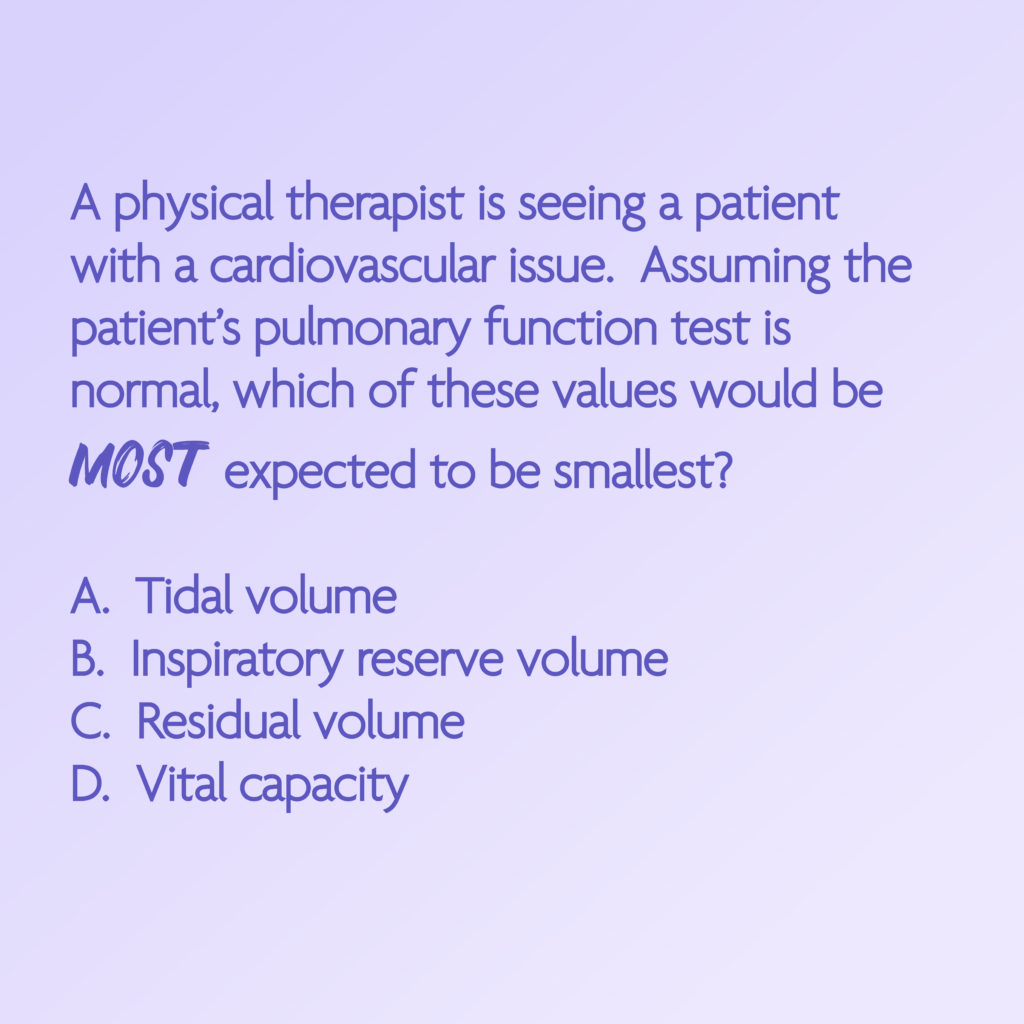
Correct answer: A
- Tidal volume is the amount of air inspired and expired during normal resting ventilation, approximately 500mL
- Inspiratory reserve volume is the volume that can be inhaled in excess of tidal breathing, approximately 2300-3000 mL
- Residual volume is the air left over, even after maximal exhalation, approximately 900-1200mL
- Vital capacity = IRV + TV + ERV. Approximately 4000-5000, but varies directly with height and indirectly with age.
Day 2
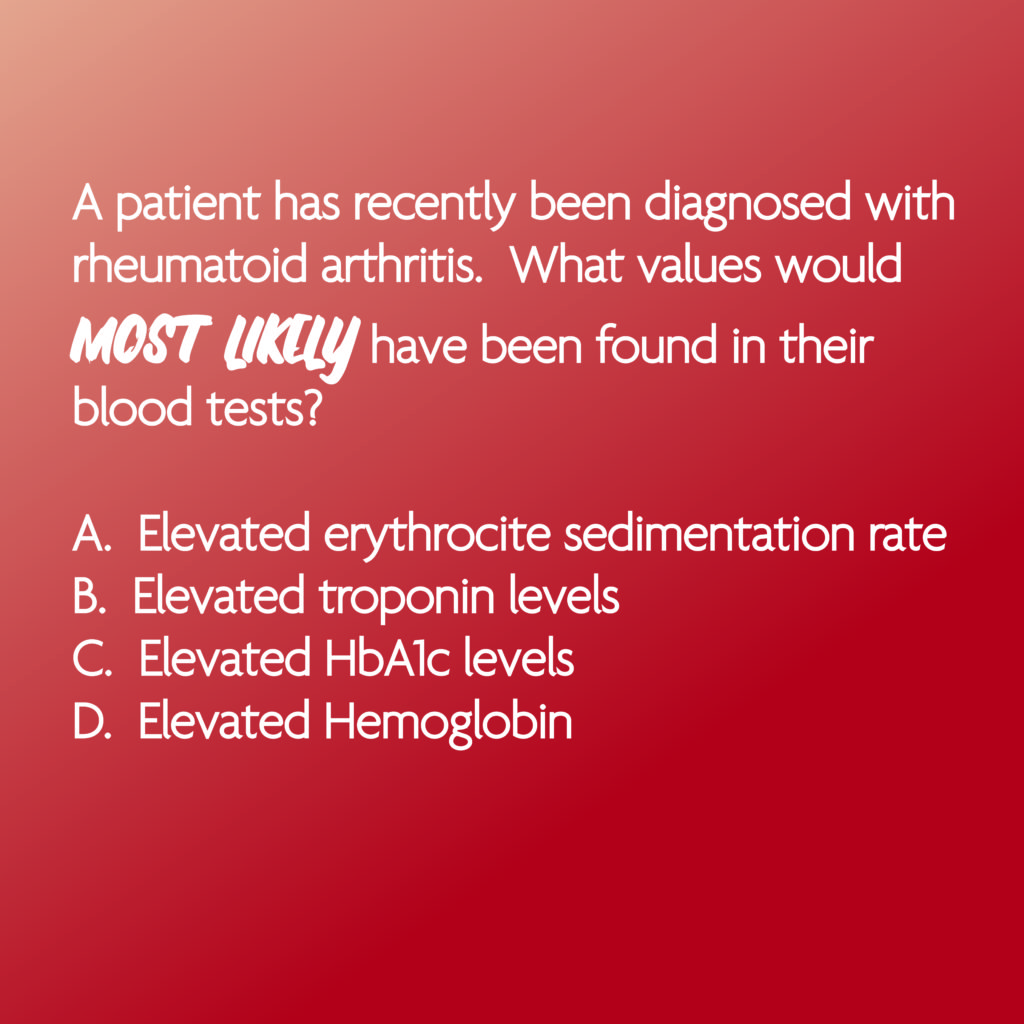
Correct answer: A
- Rheumatoid arthritis typically presents with several lab values that can help diagnose. Elevated erythrocite sedimentation rate is one of them, as this is a marker of inflammation, and RA is an inflammatory disease. Rheumatoid factors are another blood test value that would show as elevated, but I couldn’t put that because that would be too obvious.
- Elevated troponin levels usually indicate a myocardial infarction.
- Elevated HbA1c levels means that the patient’s blood glucose has been elevated for a while now, and their diabetes has not been well-managed.
- Elevated hemoglobin can indicate polycythemia, dehydration, altitude, cardiac issues, pulmonary issues, exposure to carbon monoxide, smoking, or excessive alcohol consumption.
Source: Goodman Pathology
Day 1
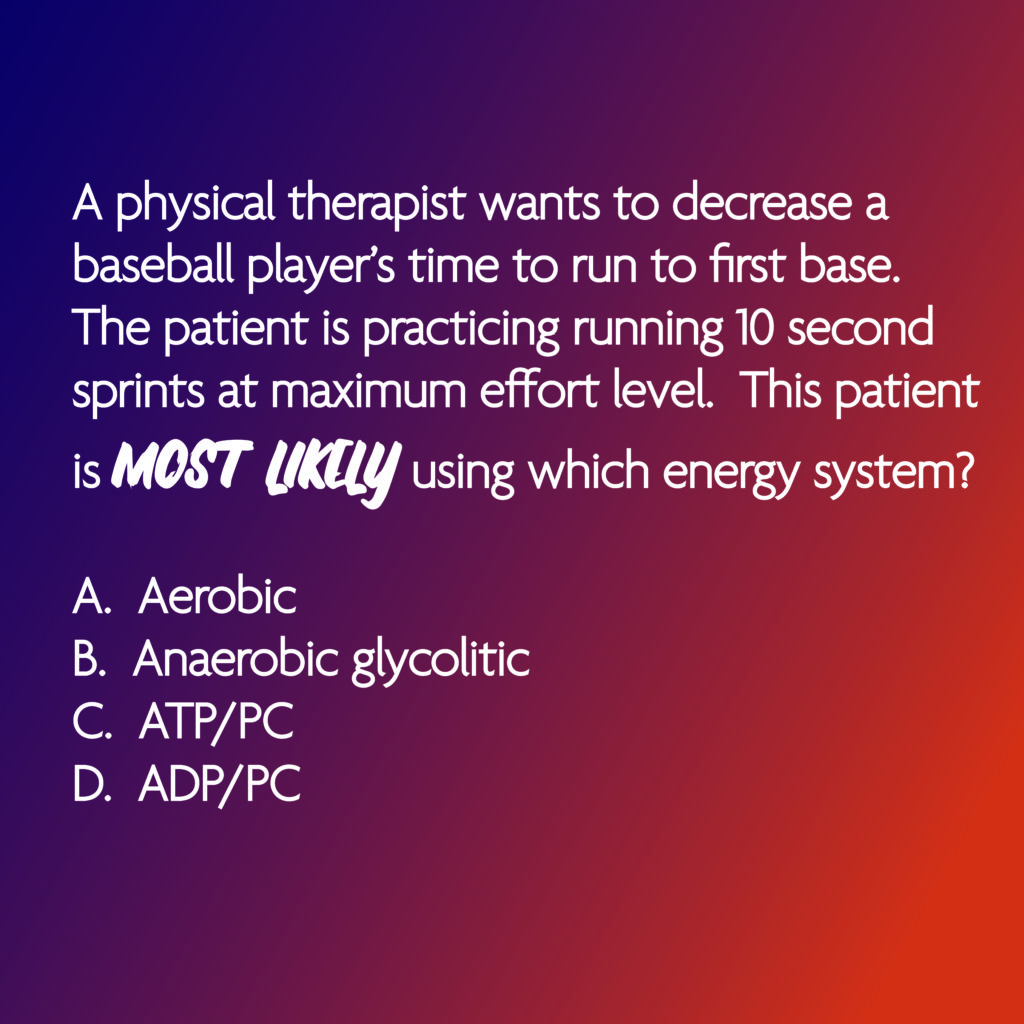
Correct answer: C
Oh by the way I have a whole post related to this
- Aerobic is for exercise lasting longer than 2 minutes, and usually for moderate intensity exercise
- Anaerobic glycolytic is for 30-90 seconds of moderate intensity exercise
- ATP-PC is for the first 30 seconds of intense exercise
- ADP-PC is not a thing
Phosphagen, or ATP-PC, System
- Phosphocreatine and ATP are stored in the muscle cell.
- Phosphocreatine is the chemical fuel source.
- No oxygen is required (anaerobic).
- When muscle is rested, the supply of ATP-PC is replenished.
- The maximum capacity of the system is small (0.7 mol ATP).
- The maximum power of the system is great (3.7 mol ATP/min).
- The system provides energy for short, quick bursts of activity.
- It is the major source of energy during the first 30 seconds of intense exercise.
Anaerobic Glycolytic System
- Glycogen (glucose) is the fuel source (glycolysis).
- No oxygen is required (anaerobic).
- ATP is resynthesized in the muscle cell.
- Lactic acid is produced (by-product of anaerobic glycolysis).
- The maximum capacity of the system is intermediate (1.2 mol ATP).
- The maximum power of the system is intermediate (1.6 mol ATP/min).
- The systems provide energy for activity of moderate intensity and short-duration.
- It is the major source of energy from the 30th to 90th second of exercise.
Aerobic System
■ Glycogen, fats, and proteins are fuel sources and are utilized relative to their availability and the intensity of the exercise.
■ Oxygen is required (aerobic).
■ ATP is resynthesized in the mitochondria of the muscle cell. The ability to metabolize oxygen and other substrates is re- lated to the number and concentration of the mitochon- dria and cells.
■ The maximum capacity of the system is great (90.0 mol ATP).
■ The maximum power of the system is small (1.0 mol ATP/min).
■ The system predominates over the other energy systems after the second minute of exercise.
Kisner & Colby, Therapeutic Exercise pg 243